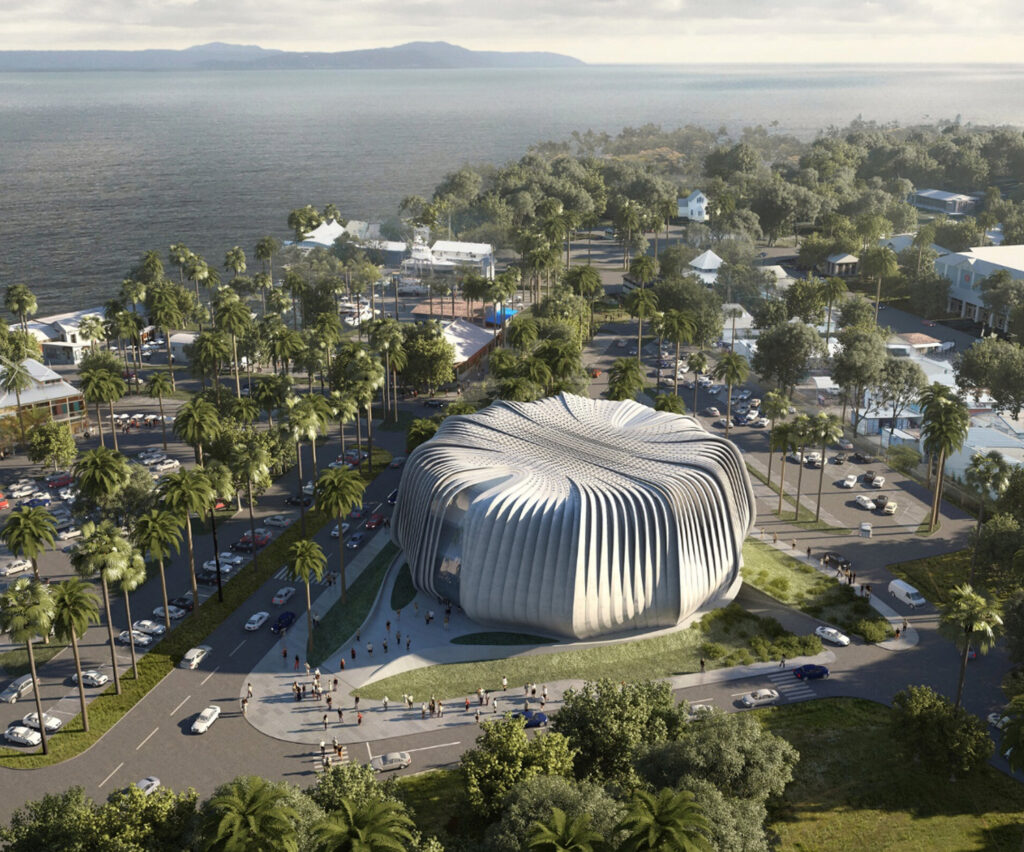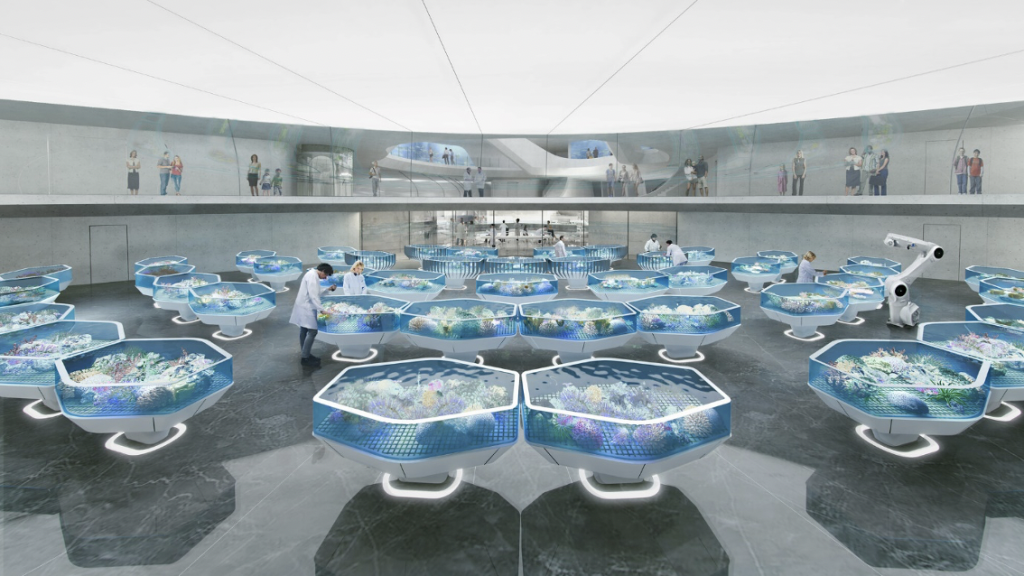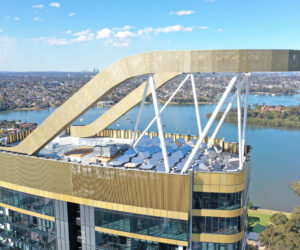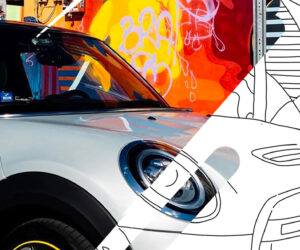World’s first dedicated coral conservation facility announced
The world’s first dedicated coral conservation facility will be located at the gateway to the Great Barrier Reef in Port Douglas, North Queensland, Australia. The Living Coral Biobank aims to secure the long-term future and biodiversity of corals worldwide which are under severe threat due to climate change.
Designed by Australian architects Contreras Earl Architecture, with leading engineering and sustainability consultants Arup and Werner Sobek for the Great Barrier Reef Legacy, the primary goal of the facility is to keep alive and nurture over 800 species of the world’s hard corals. The new building typology – a ‘living ark’ – will be the only dedicated facility of its kind in the world. Through its innovative design and engineering it will be a world leader in next-generation renewable energy design, creating optimal conditions for coral storage while minimising energy consumption and solar gain.
“The Living Coral Biobank is the only project that can secure the living biodiversity of the world’s coral species immediately,” says Dr Dean Miller, Living Coral Biobank Project Director and Managing Director of Great Barrier Reef Legacy. “To ensure this priceless living collection is held in perpetuity for generations to come we need the world’s most advanced facility that also promises to use only renewable energy sources and function with optimum efficiency, while also creating an unforgettable visitor experience – and that’s exactly what this design delivers!”
Rafael Contreras said: “This project brings with it a profound responsibility to consider the impact of architecture and the construction industry on the natural world. As one of the world’s major contributors of CO2 emissions and associated climate change, it is essential that the construction industry be encouraged by architects towards carbon neutrality. The Living Coral Biobank is an opportunity to set a global benchmark for sustainable outcomes and zero-carbon goals as well as creating a world-leading conservation and education facility. The ambition for this project is to create a beacon for environmental awareness – a centre of hope, learning and wonder.”
While the corals will be the primary building user, the 6830-square-metre multi-function centre will also host exhibition areas, an auditorium and classrooms as well as advanced research and laboratory facilities over four levels. Providing an important education resource for Port Douglas, the wider region and specialists worldwide, the Living Coral Biobank will enable visitors to get up close to live specimens in aquarium displays, learn about coral ecosystems through exhibitions and events, and observe coral husbandry experts going about their daily work in a protected wet lab environment. In addition, the facility will also have a unique 200-person function space.
The building’s sculptural form is inspired by the ‘mushroom’ coral – a hard coral identified by distinctive protective radial fins. The Living Coral Biobank’s facade is conceived as a series of organic undulating concrete fins clustered closely at ground level to offer protection from adverse tropical conditions including threats of flood. As they progress upwards the fins twist and unfurl, allowing natural light and ventilation of the upper levels while providing solar shading. The fins pull apart progressively towards Level 4 to provide a culminating visitor experience of a naturally-lit exhibition and education space.
The morphology also responds to the need to conserve the corals at lower building levels in a highly controlled environment as well as the requirement for biosecurity to prevent cross-contamination. Contreras Earl Architecture is collaborating with Arup and Werner Sobek to integrate a holistic sustainable strategy that reduces energy consumption by tactically dividing the building into six compatible climate zones over four levels, with adjacencies minimising energy resource use for climatic control. Aspiring to the biosystems of the coral reefs themselves, the building will aim to be self-sufficient and carbon neutral.
Architectural manipulation of light plays a significant role in defining the visitor journey. The experience begins at the entry plaza – a terraced forum space, providing transition space from the humid tropical heat of surrounding landscaped gardens and continues via a grand stair to the Level 2 Central Viewing Platform, from where visitors can observe the wet lab specimen tanks in a protected environment below. Public spaces across the building’s main levels are visually connected through a central atrium, with the illumination generating a surreal atmosphere through the building’s levels much like the depths of the sea. At lower levels, brightness and colour is introduced through reflections from the wet lab tanks, while cool light emanates from aquarium tanks positioned on Level 3. The fluorescence of the corals also contributes to the experience. Guests attending evening weddings and conferences will be surrounded by glowing coral species in the only function space of its kind.
The Living Coral Biobank resonates with Contreras Earl Architecture’s belief that sustainability should inform every design decision – from concept through to the choice of materials and details and onwards to construction processes. The design strives to emulate the exactness of nature where nothing is random but every characteristic has a specific purpose. It is responsive to context, climate, the user and its function to protect 800 species of coral.
Monica Earl, Contreras Earl Architecture, commented: “A childhood spent growing up in Cairns and exploring the beauty of our oceans and marvels of the Great Barrier Reef has had a profound impact on me as an architect. It was a formative part of founding a practice with the ambition to create architecture that interacts with nature in symbiotic and complimentary ways without detriment to the environment.”
“I am absolutely blown away by the new, modern design released for the Living Coral Biobank. This iconic design will be a recognisable structure which people will automatically relate back to Port Douglas,” says Douglas Shire Mayor Michael Kerr. “The unique architecture has the right feel for a globally significant and cutting-edge coral reef conservation facility to be based right here in Port Douglas. I believe the proposed state-of-the-art centre will enhance Douglas Shire’s reputation as a leader in reef conservation through innovation and science. With their drive and enthusiasm, the team at Great Barrier Reef Legacy are not only going to deliver a world-class preservation project, but give Port Douglas another special attraction for visitors to enjoy. Our community has a real opportunity to own this project while making a really positive difference to the environment and the future of the Great Barrier Reef.”
Richard Vincent, Associate Principal Arup said: “The Living Coral Bio Bank will help create a legacy so that future generations may enjoy the Great Barrier Reef. This landmark building will offer state-of-the-art facilities, with innovation and sustainability at its heart, creating a resilient development that will benefit research and make a fundamental difference to the survival of one of the natural wonders of the world.”
Thomas Winterstetter, Managing Director, Werner Sobek said: “Sustainability is at the core of our approach towards design and engineering. It’s rare to find a project which allows us to promote sustainability both with regard to our services and to the building’s functions at the same time. Therefore, we are delighted to be part of this important enterprise.”
Amanda McKenzie, CEO of the Climate Council said: “The Biobank building will be of immense importance for coral conservation and the community of Port Douglas. As an education, research and design experience, it will contribute to the town’s resilience, development and enhance its worldwide recognition as the gateway to the world’s ever-more precious resource that is the Great Barrier Reef. The Climate Council applauds this wonderful initiative.”




